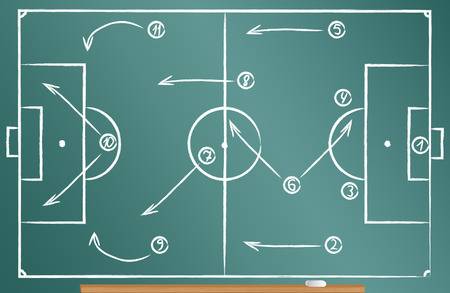I watch a lot of soccer. For 15 years or so now it’s been something of an obsession. I’m painfully aware however, that this does not make me an expert. I’ve spent time trying to educate myself on the intricacies of the game, but I’m always a little apprehensive when I write something tactical. I spend a lot of time trying to get things right and run it by people smarter than me.
This column will (hopefully) help me and others watch games in a different way. I’ve reached out to several coaches over the last year and one finally responded. Omid Namazi graciously agreed to answer some questions and advise as I wrote this. Much of the information you are about to read is taken directly from him as we have corresponded back and forth.
If you are unaware, Omid is currently an assistant coach under Tab Ramos with the Houston Dynamo. He was also the head coach of the men’s U18 US youth national team and assistant with the U20s (many other coaching jobs as well). Dude, knows his stuff.
Where to Start?
The first task is to determine what each team is trying to achieve. Or maybe what system of play the team is using would be another way to say it. Is the team sitting back, inviting the other team forward and then hitting quickly into the space behind? Are they pressing high and trying to create turnovers in the opposition’s half? Ascertaining the goal of each team can help you understand why the players on the team are moving the way that they are, playing certain passes repeatedly, etc.
This is the USMNT playing Uruguay in a friendly. Can you see them trying to suck the US in and break?

Identifying the Formation
This is something I always like to try to do even if it isn’t of critical importance. Many coaches will insist that formations don’t matter since individual players have different assignments. Even so, I feel like it’s a good starting point and lets you generally know where to look for players on the field.
One of the quickest ways to determine the formation (especially on defense) is to look just before kick off. Here’s Derby County just before the second half started in the game against Charlton when they were down to 10 men:

It’s a little harder when a team is in possession of the ball. Players tend to move around, switch, make runs and whatnot. All that trying to score nonsense. 😂 Plus, many teams (especially possession based sides) have a different formation in the buildup than they do when defending. I’ve found it’s easiest to identify the “offensive” formation in moments when the team is in calm possession of the ball (recycling it around the back, just getting into the opponent’s half, etc.) This pic is from the USMNT’s friendly against Ecuador in March, 2019. Also known as the only game where Tyler Adams actually played that “false right back” position:

An Actual Advertiser!
No idea how many people know this, but the ads that usually show up in these articles are a Google service that pays basically nothing and it doesn’t pay out until you hit $100. 😑 I’ve written 82 articles in just under a year and I haven’t hit $100 yet. I’m doing this for fun, but a little money never hurt anybody, right? 😂 Which brings us to Away Days…
Away Days is a soccer clothing startup based in Boston, MA that offers unique/cool soccer stuff. It’s a one person operation, but Martin will make sure you are taken care of no matter what. The company is known for the Mystery Kit, which for $25, Martin will send you a brand new jersey from a “lesser known” team. Away Days also has their own branded clothing line (hoodies, t-shirts, hats, etc), partners with US clubs to sell their jerseys, and offers a host of other mystery products. If you are looking for awesome soccer gear and customer service, look no further than http://awaydaysfootball.com.
I’ve done the mystery kit thing twice. Once for me and once for my son. We got Nottingham Forest and FC Wacker. 😂 It’s legit. My apologies for the interruption…back to soccer.
The Defenders
Everyone has heard the old cliche, “a well organized defense.” When watching the back four (or three) of a defense watch how in sync and coordinated their movements are. A good back line will have small spaces between the players. Watch Mexico’s back line here against Germany from the 2018 World Cup.

On the other hand, we have Schalke. In this clip the center backs (Weston was a cb here unfortunately) are spread fairly wide which leaves a gap and allows a quality scoring chance for Leverkusen.

Another key is having the defenders in sync with their defensive midfielder(s) as well. The midfielder obviously has more freedom to move around and join the attack a little, but when in defense the #6 is connected as the tip of a triangle with the center backs. If a CB steps out then the defensive mid fills in. Watch Brozovic (in black, next to the ref), Croatia’s d-mid, stay between and in front of his center backs with England in possession.

Midfield
Much like defenders, the midfielders need to stay connected. Midfielders read each other’s movements and move in response. Here’s an example of a three man midfield rotation.
This occurs in possession and works much more effectively when opponents are man-marking. If the defense is marking zonally then the midfielders don’t get followed and space doesn’t open up.
To overcome zonal defense offenses can “overload” zones. Think of it like American football. If a corner is trying to cover two receivers in his zone…he’s in trouble. In a similar way, if you can get three players into an area with two defenders, you’re in business.
Connectedness in the Midfield
When out of possession the midfield should behave similarly to the backline. The line of three or four should not get too spread apart as they shift side to side in response to the opponent. Here’s an example from Atletico Madrid:

You can see Atletico’s right mid/right center mid slide back centally as the left mid/left center mid move in response to Barcelona’s circulation of the ball.
Forward Play
Joining the Midfield
Forwards behave differently in different systems, but their function is essentially the same: create space/take advantage of space and score goals. When Altidore is playing forward for the US he is a good example of a forward “dropping in” to create overloads in midfield.
If Altidore can withdraw into midfield without being followed by a center back then the US suddenly has numerical superiority in the midfield. This gives the team the ability to maintain possession in dangerous areas. And if the center back does follow the forward it creates space for the wingers to run into. The key to this is the outside forwards/wingers making runs that threaten areas those center backs need to protect.

Here’s a real life example of Messi doing it and he’s you know, almost as good as Jozy. 😂
Running in Behind
This is something we’d see more often with Zardes playing than Altidore/Sargent, but is another method of creating space. To steal from American football again, runs in behind can “stretch the field.” If a receiver is known to be exceptionally fast, safeties/corners back off in coverage which creates more room in the middle of the field. In soccer, a fast player can accomplish much the same task. Here’s an example of Jamie Vardy doing it for Leicester City:

As Vardy runs toward goal space opens up between the line of defenders and the midfielders. Maddison is able to exploit the open area to score a great goal. This stretching of the defensive lines is another strategy to watch for when attempting to take in matches more analytically.
Was this Helpful?
I know it has been for me. Not only has asking Omid questions been informative, but watching tons of tactical videos in the process has been educational as well. Hopefully, laying it out in this way provides a couple general keys to look for and then an idea or two in each area of the field. Thanks one more time to Mr. Namazi for consulting. Give him a follow on Twitter if you’d like @onamazi.
If you enjoyed this and would like to be informed of future articles type your email address in the box and you’ll be notified of each new post. Also, feel free to follow me on Twitter @blharreld 🤓







Excellent. Need more like this. Thx.